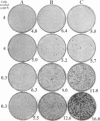Abstract
Foulds introduced six rules of tumor progression based on his observations of spontaneous mammary cancer in mice and generalized them to all forms of neoplasia [Foulds, L. (1954) Cancer Res. 14, 327-339 and Foulds, L. (1969) Neoplastic Development (Academic, New York), Vol. 1, preface and pp. 72-74.] Rules III, IV, and V are considered controversial, and research in animals seems inadequate to resolve the controversies. A subline of NIH 3T3 cells undergoes progressive transformation to produce foci of increasing population density when repeatedly constrained by sequential rounds of growth to and maintenance at confluence. Analysis of the results provides a cellular basis for rules III, IV, and V. Rule III states that progression is independent of the growth of the tumor and occurs in tumors that are arrested. Cell culture shows that progression is actually favored by constraint of growth, a result inconsistent with a major role for point mutations in progression. Indeed, there is a suggestion that the transformation may arise from chromatin changes preceding apoptosis. Rule IV states that progression can be gradual or abrupt but the latter conclusion has been frequently criticized. Cell culture exhibits both forms of progression but, in particular, eliminates the doubt about the abrupt form. Rule V, which is in a sense an extension of rule IV, states that progression follows one of alternative paths of development. The results in culture indicate that every independent transforming event gives rise to foci of unique morphology. Thus, even for the single characteristic of transformed focus morphology, many alternative paths to neoplasia are available to cells. In addition to clarifying the rules of progression, a method is described for pinpointing the time of the occurrence of events that are only expressed as dense foci after a variable lag time. The results in culture reinforce Foulds' conclusion that neoplastic development is primarily an epigenetically driven process and identify some of the cellular interactions that underlie that process.
Full text
PDF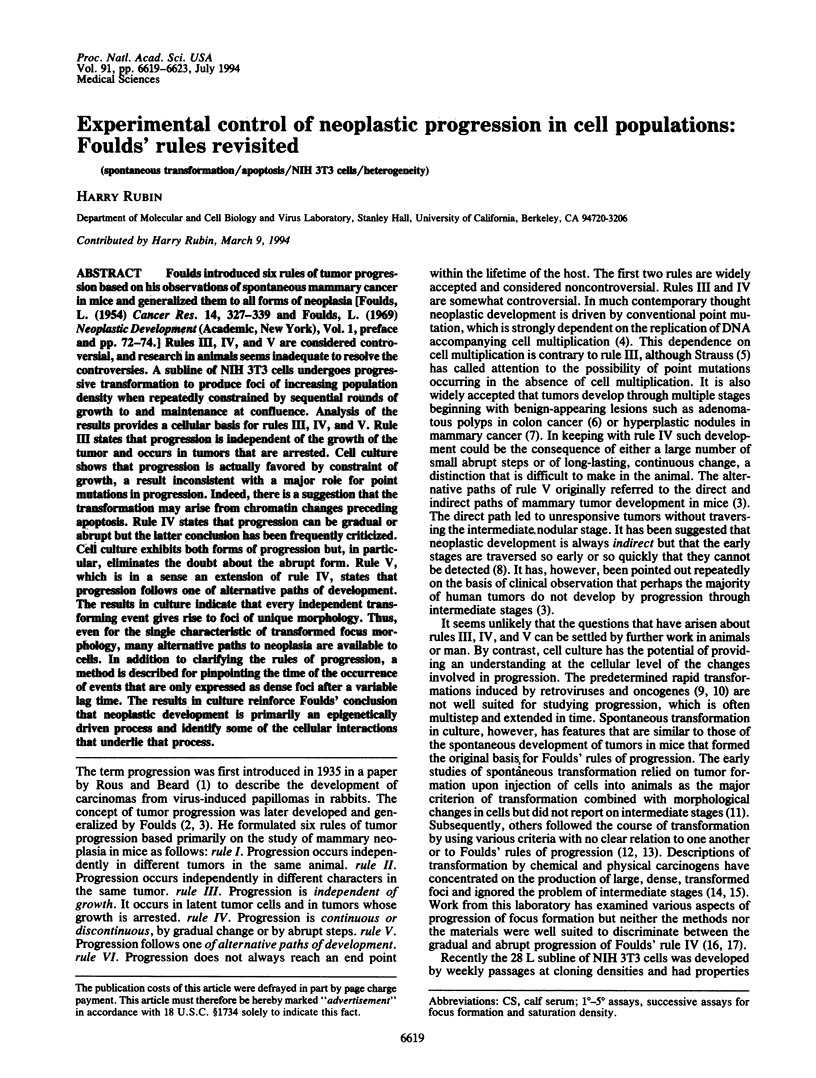
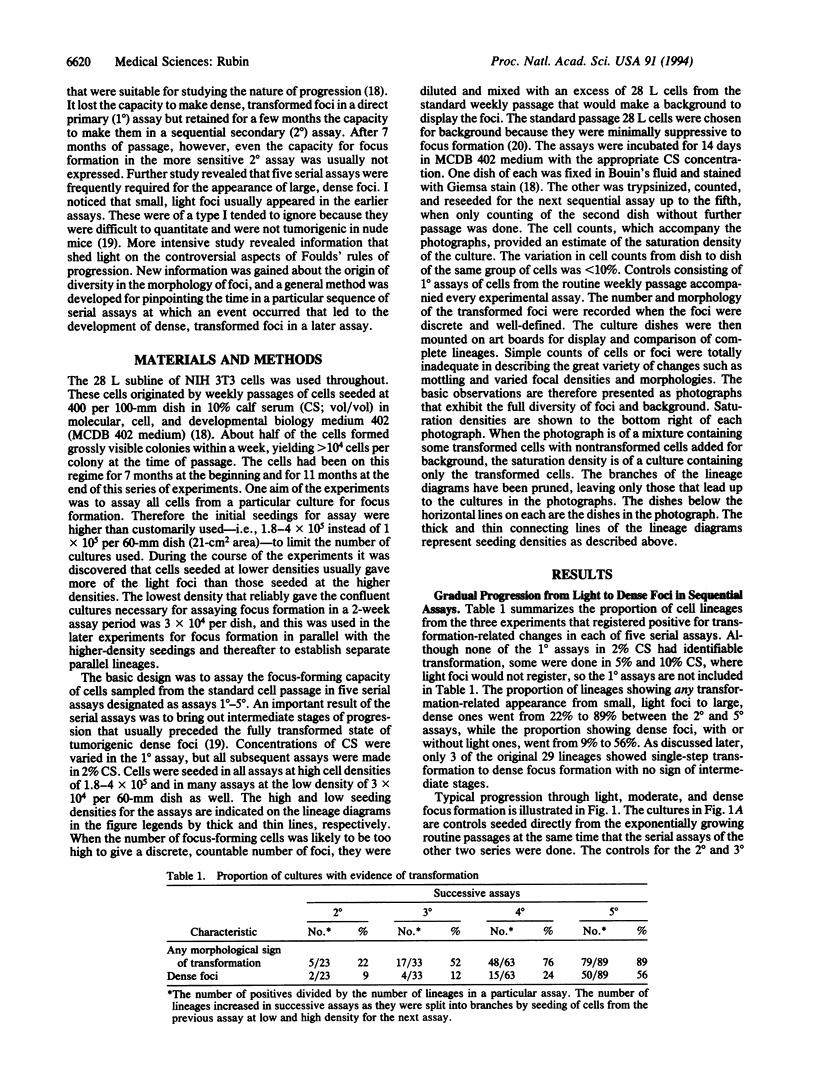
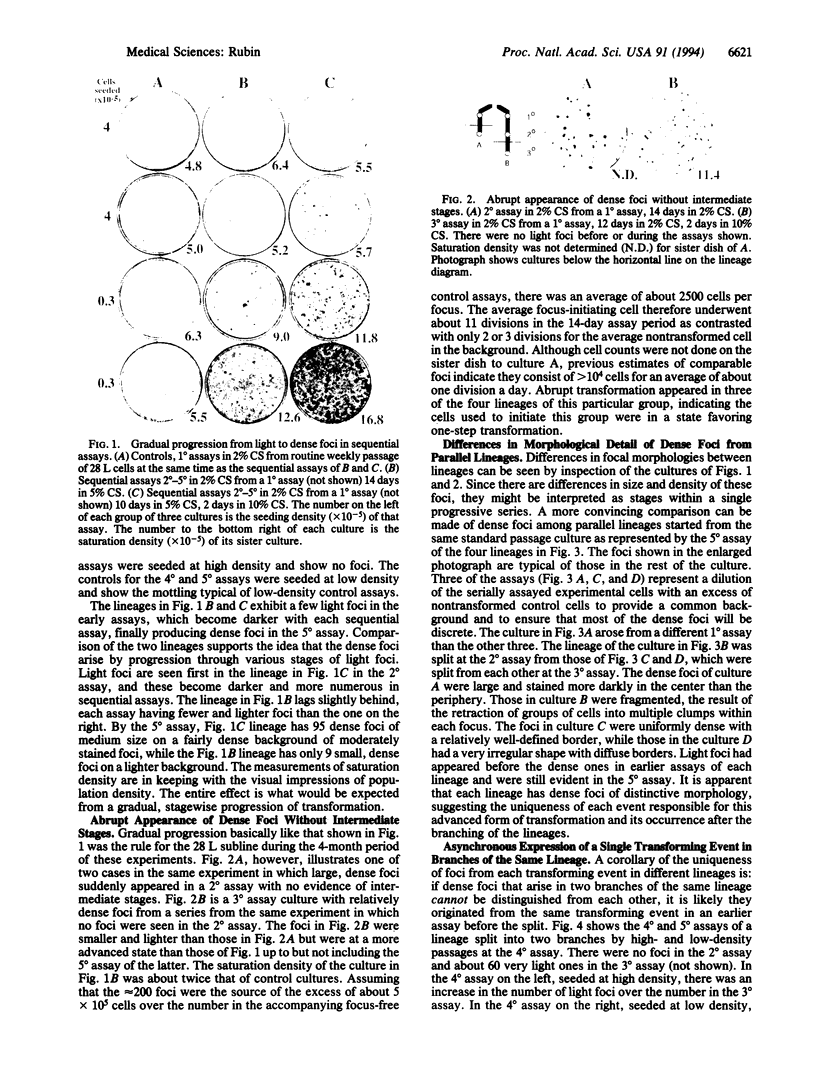
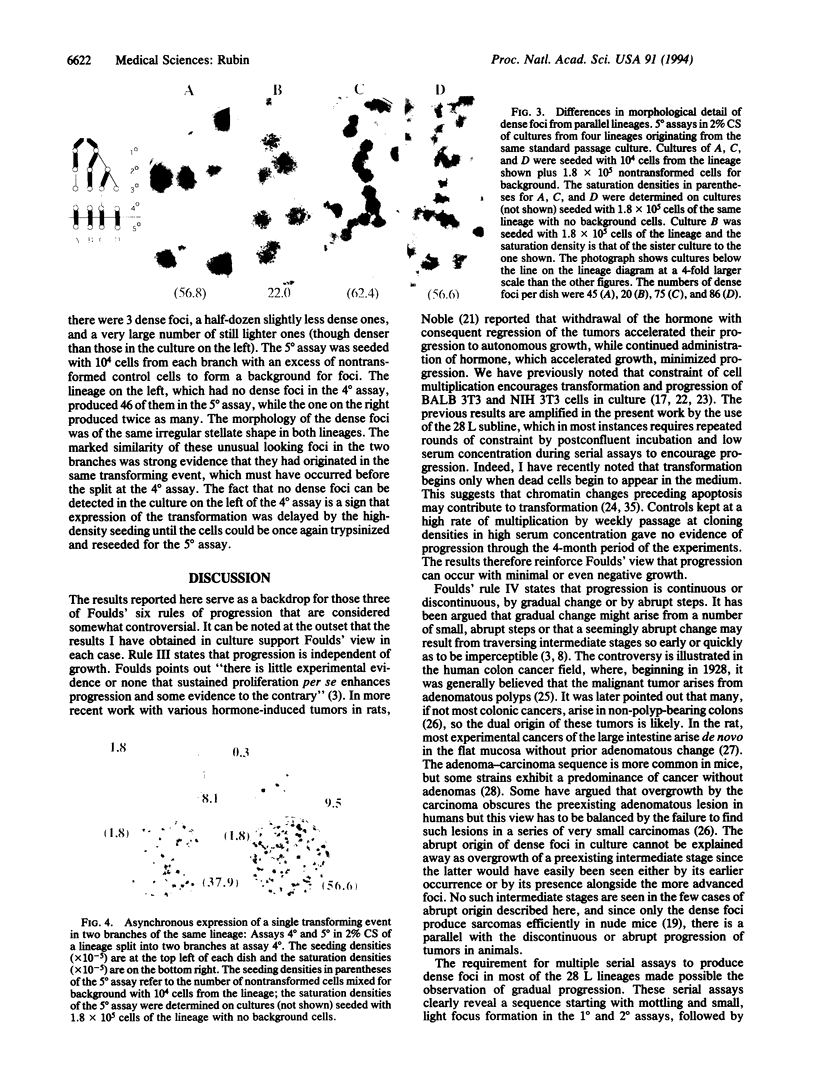
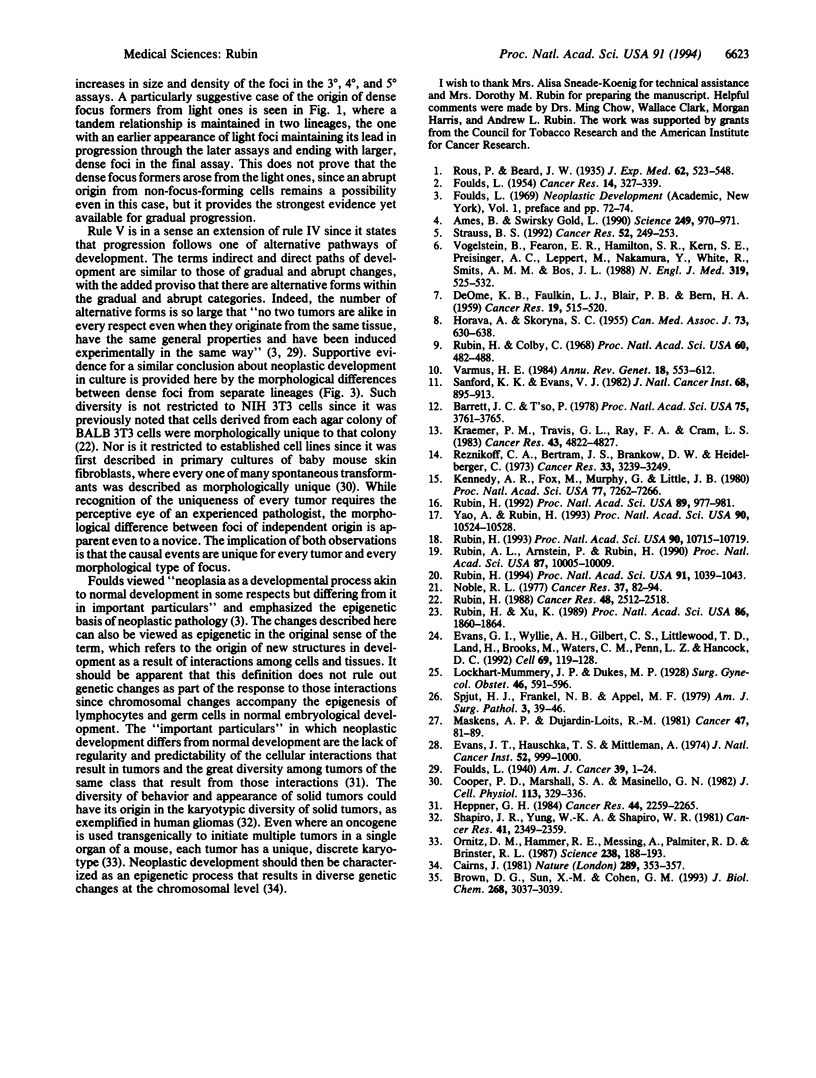
Images in this article
Selected References
These references are in PubMed. This may not be the complete list of references from this article.
- Ames B. N., Gold L. S. Too many rodent carcinogens: mitogenesis increases mutagenesis. Science. 1990 Aug 31;249(4972):970–971. doi: 10.1126/science.2136249. [DOI] [PubMed] [Google Scholar]
- Barrett J. C., Ts'o P. O. Evidence for the progressive nature of neoplastic transformation in vitro. Proc Natl Acad Sci U S A. 1978 Aug;75(8):3761–3765. doi: 10.1073/pnas.75.8.3761. [DOI] [PMC free article] [PubMed] [Google Scholar]
- Brown D. G., Sun X. M., Cohen G. M. Dexamethasone-induced apoptosis involves cleavage of DNA to large fragments prior to internucleosomal fragmentation. J Biol Chem. 1993 Feb 15;268(5):3037–3039. [PubMed] [Google Scholar]
- Cairns J. The origin of human cancers. Nature. 1981 Jan 29;289(5796):353–357. doi: 10.1038/289353a0. [DOI] [PubMed] [Google Scholar]
- Cooper P. D., Marshall S. A., Masinello G. R. Rapid induction of foci escaping density-dependent inhibition in baby mouse skin cultures. J Cell Physiol. 1982 Nov;113(2):329–336. doi: 10.1002/jcp.1041130223. [DOI] [PubMed] [Google Scholar]
- DEOME K. B., FAULKIN L. J., Jr, BERN H. A., BLAIR P. B. Development of mammary tumors from hyperplastic alveolar nodules transplanted into gland-free mammary fat pads of female C3H mice. Cancer Res. 1959 Jun;19(5):515–520. [PubMed] [Google Scholar]
- Evan G. I., Wyllie A. H., Gilbert C. S., Littlewood T. D., Land H., Brooks M., Waters C. M., Penn L. Z., Hancock D. C. Induction of apoptosis in fibroblasts by c-myc protein. Cell. 1992 Apr 3;69(1):119–128. doi: 10.1016/0092-8674(92)90123-t. [DOI] [PubMed] [Google Scholar]
- Evans J. T., Hauschka T. S., Mittelman A. Differential susceptibility of four mouse strains to induction of multiple large-bowel neoplasms by 1,2-dimethylhydrazine. J Natl Cancer Inst. 1974 Mar;52(3):999–1000. doi: 10.1093/jnci/52.3.999. [DOI] [PubMed] [Google Scholar]
- FOULDS L. The experimental study of tumor progression: a review. Cancer Res. 1954 Jun;14(5):327–339. [PubMed] [Google Scholar]
- HORAVA A., SKORYNA S. C. Observations on the pathogenesis of neoplasia. Can Med Assoc J. 1955 Oct 15;73(8):630–638. [PMC free article] [PubMed] [Google Scholar]
- Heppner G. H. Tumor heterogeneity. Cancer Res. 1984 Jun;44(6):2259–2265. [PubMed] [Google Scholar]
- Kennedy A. R., Fox M., Murphy G., Little J. B. Relationship between x-ray exposure and malignant transformation in C3H 10T1/2 cells. Proc Natl Acad Sci U S A. 1980 Dec;77(12):7262–7266. doi: 10.1073/pnas.77.12.7262. [DOI] [PMC free article] [PubMed] [Google Scholar]
- Kraemer P. M., Travis G. L., Ray F. A., Cram L. S. Spontaneous neoplastic evolution of Chinese hamster cells in culture: multistep progression of phenotype. Cancer Res. 1983 Oct;43(10):4822–4827. [PubMed] [Google Scholar]
- Maskens A. P., Dujardin-Loits R. M. Experimental adenomas and carcinomas of the large intestine behave as distinct entities: most carcinomas arise de novo in flat mucosa. Cancer. 1981 Jan 1;47(1):81–89. doi: 10.1002/1097-0142(19810101)47:1<81::aid-cncr2820470115>3.0.co;2-t. [DOI] [PubMed] [Google Scholar]
- Noble R. L. Hormonal control of growth and progression in tumors of Nb rats and a theory of action. Cancer Res. 1977 Jan;37(1):82–94. [PubMed] [Google Scholar]
- Ornitz D. M., Hammer R. E., Messing A., Palmiter R. D., Brinster R. L. Pancreatic neoplasia induced by SV40 T-antigen expression in acinar cells of transgenic mice. Science. 1987 Oct 9;238(4824):188–193. doi: 10.1126/science.2821617. [DOI] [PubMed] [Google Scholar]
- Reznikoff C. A., Bertram J. S., Brankow D. W., Heidelberger C. Quantitative and qualitative studies of chemical transformation of cloned C3H mouse embryo cells sensitive to postconfluence inhibition of cell division. Cancer Res. 1973 Dec;33(12):3239–3249. [PubMed] [Google Scholar]
- Rubin A. L., Arnstein P., Rubin H. Physiological induction and reversal of focus formation and tumorigenicity in NIH 3T3 cells. Proc Natl Acad Sci U S A. 1990 Dec;87(24):10005–10009. doi: 10.1073/pnas.87.24.10005. [DOI] [PMC free article] [PubMed] [Google Scholar]
- Rubin H. Adaptive evolution of degrees and kinds of neoplastic transformation in cell culture. Proc Natl Acad Sci U S A. 1992 Feb 1;89(3):977–981. doi: 10.1073/pnas.89.3.977. [DOI] [PMC free article] [PubMed] [Google Scholar]
- Rubin H. Cellular epigenetics: control of the size, shape, and spatial distribution of transformed foci by interactions between the transformed and nontransformed cells. Proc Natl Acad Sci U S A. 1994 Feb 1;91(3):1039–1043. doi: 10.1073/pnas.91.3.1039. [DOI] [PMC free article] [PubMed] [Google Scholar]
- Rubin H. Cellular epigenetics: effects of passage history on competence of cells for "spontaneous" transformation. Proc Natl Acad Sci U S A. 1993 Nov 15;90(22):10715–10719. doi: 10.1073/pnas.90.22.10715. [DOI] [PMC free article] [PubMed] [Google Scholar]
- Rubin H., Colby C. Early release of growth inhibition in cells infected with Rous sarcoma virus. Proc Natl Acad Sci U S A. 1968 Jun;60(2):482–488. doi: 10.1073/pnas.60.2.482. [DOI] [PMC free article] [PubMed] [Google Scholar]
- Rubin H. Uniqueness of each spontaneous transformant from a clone of BALB/c 3T3 cells. Cancer Res. 1988 May 1;48(9):2512–2518. [PubMed] [Google Scholar]
- Rubin H., Xu K. Evidence for the progressive and adaptive nature of spontaneous transformation in the NIH 3T3 cell line. Proc Natl Acad Sci U S A. 1989 Mar;86(6):1860–1864. doi: 10.1073/pnas.86.6.1860. [DOI] [PMC free article] [PubMed] [Google Scholar]
- Sanford K. K., Evans V. J. A quest for the mechanism of "spontaneous" malignant transformation in culture with associated advances in culture technology. J Natl Cancer Inst. 1982 Jun;68(6):895–913. [PubMed] [Google Scholar]
- Shapiro J. R., Yung W. K., Shapiro W. R. Isolation, karyotype, and clonal growth of heterogeneous subpopulations of human malignant gliomas. Cancer Res. 1981 Jun;41(6):2349–2359. [PubMed] [Google Scholar]
- Spjut H. J., Frankel N. B., Appel M. F. The small carcinoma of the large bowel. Am J Surg Pathol. 1979 Feb;3(1):39–46. doi: 10.1097/00000478-197902000-00005. [DOI] [PubMed] [Google Scholar]
- Strauss B. S. The origin of point mutations in human tumor cells. Cancer Res. 1992 Jan 15;52(2):249–253. [PubMed] [Google Scholar]
- Varmus H. E. The molecular genetics of cellular oncogenes. Annu Rev Genet. 1984;18:553–612. doi: 10.1146/annurev.ge.18.120184.003005. [DOI] [PubMed] [Google Scholar]
- Vogelstein B., Fearon E. R., Hamilton S. R., Kern S. E., Preisinger A. C., Leppert M., Nakamura Y., White R., Smits A. M., Bos J. L. Genetic alterations during colorectal-tumor development. N Engl J Med. 1988 Sep 1;319(9):525–532. doi: 10.1056/NEJM198809013190901. [DOI] [PubMed] [Google Scholar]
- Yao A., Rubin H. Automatic enumeration and characterization of heterogeneous clonal progression in cell transformation. Proc Natl Acad Sci U S A. 1993 Nov 15;90(22):10524–10528. doi: 10.1073/pnas.90.22.10524. [DOI] [PMC free article] [PubMed] [Google Scholar]



